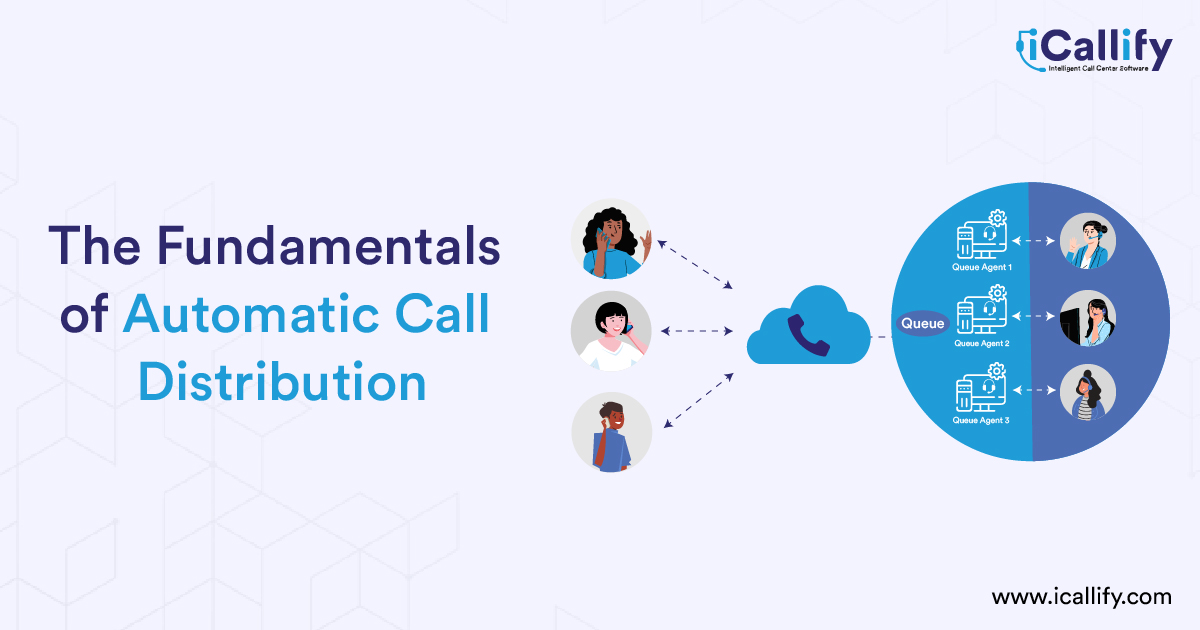
Modern call center solutions are loaded with the best features and functionalities. Automation is the major emphasis of modern solutions. One of the most popular automation features available in modern contact center solutions is automatic call distribution. Some companies do not use full fledged intelligent call center software. Rather they use an automatic call distribution system.
With mounting popularity, the features and capabilities of this solution have also risen. To give you a more detailed understanding of this automation solution, we have jotted down the important facts and fundamentals of automatic call distribution (ACD).
What is Automatic Call Distribution ?
As the name suggests it automates the process of distributing calls.
In a call center or business that handles massive incoming call volume, effectively handling calls becomes crucial. Moreover, in such organizations, more than one department exists. The calls get routed to the right department. The automatic call distribution software automates this process of routing calls to the right agent in the right department.
The modern day ACD and contact center solutions consist of multiple automated call routing rules.
What are the major types of ACD?
Different call center solutions can have different types of ACD rules and it completely depends on the provider. However, there are some rules that are must have for successful operations of incoming call centers or businesses. Thus, the following are must have rules in your automatic call distribution system.
1. Skill based call routing
As the name suggests, this rule analyzes an incoming call depending on the criteria of customer type, query or concern, spoken language, skills required to resolve the query, etc. Based on this information, it maps the agent skills stored in the software and routes the call to the call queue of an agent that has most of the skills to resolve customer concerns. The ACD solution provider incorporates this as one of the fundamental call routing strategies to help call centers increase customer satisfaction.
Improve call management with Automatic Call Distribution
Improve call management with Automatic Call Distribution
2. Sticky Agent
In a business in which customer experience is the prime concern, the sticky agent is the most useful ACD. It makes sure that every time a customer contacts the business, his or her call gets connected with the same agent. This helps in boosting customer relationships and thus, it is a must have ACD.
3. Least talk time call routing rule
In call centers, agent productivity is as important as customer experience. The least talk time call routing strategy helps in giving equal opportunity to all agents to perform better and productively. It identifies agents with the least talk time during the shift compared to other agents and assigns calls to that agent.
Call centers and customer service operations rely on Automatic Call Distribution (ACD) technology to efficiently manage incoming phone calls. ACD systems design call distribution among available agents or representatives to optimize customer service and reduce wait times.Let’s delve into the fundamental aspects of ACD:
Also Read: Automatic Call Distribution Software Solution & Its Importance
How Automatic Call Distribution Works:
ACD systems work by intelligently routing incoming calls to the most suitable agents or representatives based on various criteria. Here’s an overview of how ACD operates:
Incoming Call Routing:
- When a customer dials a company’s phone number, the ACD system receives the call.
- The ACD system then evaluates factors like caller input (IVR selections), caller ID, time of day, and agent availability to determine how to handle the call.
Queue Management:
- If all agents are busy or unavailable, the call is placed in a queue.
- Calls in the queue are typically held in the order they were received, although some prioritization may occur based on certain criteria.
Agent Assignment:
- As agents become available, the ACD system assigns the waiting calls to the most suitable agent.
- This assignment can be done using various algorithms, such as Round Robin, Skills-Based Routing, or Least Occupied Agent.
Call Monitoring:
- Supervisors or managers can monitor ongoing calls to ensure quality and compliance.
- This feature allows for coaching, training, and maintaining service standards.
ACD Algorithms:
Several algorithms are used to determine how calls are assigned to agents within an ACD system. Here are some common ones:
Round Robin:
- Commonly used in ACD, the Round Robin algorithm evenly distributes calls among available agents. The algorithm operates in a cyclic fashion, ensuring that each agent gets an equal share of calls over time. Here’s how it works:
- When a call arrives, the ACD system assigns the call to the next available agent in a sequential manner, starting from the agent who received the last call.
- If an agent is unavailable or on another call, the system moves to the next available agent in the list.
- The process continues in a round-robin fashion, looping back to the first agent once all agents have received a call.
- This algorithm helps in maintaining a balanced workload among agents, promoting fairness in call distribution.
Also Read: ACD vs. Auto Dialer: Everything You Need to Know
Skills-Based Routing:
- Skills-Based Routing is an ACD algorithm that routes calls to agents based on their specific skills, expertise, or qualifications. The goal is to match each call with an agent who is best equipped to handle the caller’s needs. Here’s how it works:
- The ACD system categorizes agents based on their skills, knowledge, or proficiency in various areas.
- When a call arrives, the system assesses the call’s nature and directs it to a suitable agent with the necessary skills to meet the caller’s needs.
- This ensures that the system connects the caller to an agent who possesses expertise in addressing their specific issue, resulting in a more efficient and satisfactory interaction.
- Skills-Based Routing enhances customer satisfaction by providing personalized assistance and expertise tailored to the caller’s needs.
Least Occupied Agent:
- The Least Occupied Agent algorithm focuses on directing calls to the agent who is currently the least busy or has the shortest average call time. Here’s how it operates:
- When a call arrives, the ACD system assesses agents’ workload by considering ongoing call volume and average call durations they manage.
- The system routes the call to the agent managing the least calls or with the shortest average call time, achieving workload balance.
- This algorithm enhances efficiency and minimizes wait times for callers by directing calls to available agents.
Conclusion
In conclusion, automatic call distribution software provides multiple features to the business to handle incoming calls in different ways. An ACD solution provider aims to improve the efficiency of handling calls and increasing the performance of a business. The Call Center business using an automatic call distribution system also focuses on increasing customer satisfaction and retention. All this makes it necessary to care about ACD rules.



Leave a comment